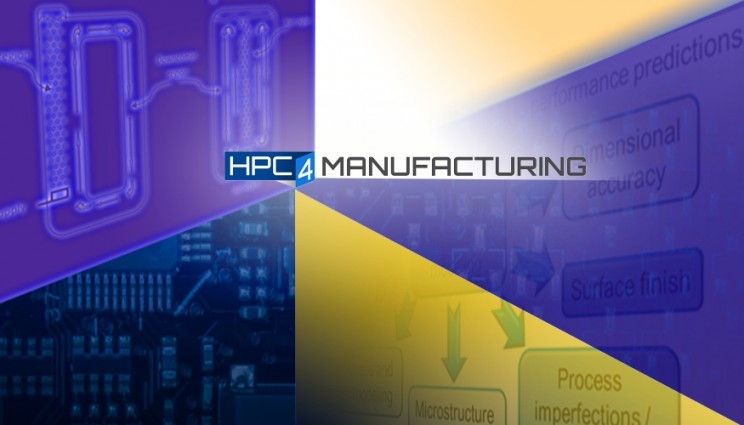DOE funds 'HPC for manufacturing' projects
 (Download Image)
Industry projects are among the first to be selected for funding and partnerships with national labs under the U.S. Department of Energy’s High Performance Computing for Manufacturing (HPC4Mfg) Program. Lawrence Livermore National Laboratory leads the program, with Lawrence Berkeley and Oak Ridge National Laboratories as strong partners.
(Download Image)
Industry projects are among the first to be selected for funding and partnerships with national labs under the U.S. Department of Energy’s High Performance Computing for Manufacturing (HPC4Mfg) Program. Lawrence Livermore National Laboratory leads the program, with Lawrence Berkeley and Oak Ridge National Laboratories as strong partners.
Lawrence Livermore National Laboratory and partners announce 10 new industry projects to advance manufacturing using high performance computing under a DOE program
Industry projects ranging from improved turbine blades for aircraft engines and reduced heat loss in electronics to waste reduction in paper manufacturing and improved fiberglass production are among the first to be selected for funding and partnerships with national labs under the U.S. Department of Energy’s (DOE) High Performance Computing for Manufacturing (HPC4Mfg) Program. Lawrence Livermore National Laboratory (LLNL) leads the program and partners with Lawrence Berkeley and Oak Ridge National Laboratories (LBNL and ORNL).
Each of the 10 Phase I projects will be funded at approximately $300,000 for a total of just under $3 million. Selected companies will partner with national labs, which will provide expertise in and access to high performance computing systems aimed at high-impact challenges. The Advanced Manufacturing Office (AMO) within DOE’s Office of Energy Efficiency and Renewable Energy (EERE), created this program to advance clean energy technologies, increase the efficiency of manufacturing processes, accelerate innovation, shorten the time it takes to bring new technologies to market and improve the quality of products. The HPC4Mfg projects also support the Energy Department’s broader Clean Energy Manufacturing Initiative to increase U.S. competitiveness through manufacturing clean energy technologies, boosting energy productivity and leveraging low-cost domestic energy resources and feedstocks.
David Danielson, DOE’s assistant secretary for EERE, announced the projects today during an online media presentation highlighting the program and the awardees. On AMO’s behalf, LLNL established HPC4Mfg in March 2015, launched four "seedling" projects and put in place a formal governance model. LBNL and ORNL joined in September 2015 to support the Phase I solicitation, which was originally announced by Danielson at the American Energy and Manufacturing Competitiveness Summit in Washington, D.C. that month.
"Access to supercomputers in the Department of Energy’s labs will provide a resource to American firms inventing and building clean energy technologies right here at home that no international competitor can match," Danielson said. "The HPC4Mfg initiative pairs leading clean energy technology companies with the world-class computing tools and expertise at our national labs to drive down the cost of materials and streamline manufacturing processes. The ultimate goal of their collaboration is to increase our global competitiveness in the race to develop clean energy technology and jobs."
This effort also will advance President Obama's National Strategic Computing Initiative (NSCI). The NSCI, which Obama unveiled in July 2015, calls for public-private partnerships to increase industrial adoption of high-performance computing.
Under the HPC4Mfg program, the selected projects will apply modeling, simulation and data analysis to industrial products and processes to lower production costs and accelerate development of new clean energy technologies. An overarching objective is to keep the United States at the forefront of innovation in advanced clean energy technologies and energy efficiency techniques.
Selected Phase I projects:
Global Foundries of New York; Lightweight Innovations for Tomorrow Consortium in Michigan; ZoomEssence Inc. of Kentucky; United Technologies Research Center of Connecticut; Procter & Gamble of Ohio; General Electric (GE), New York (two projects); PPG Industries Inc. of North Carolina (two projects); and the Ohio Supercomputer Center (OSC) /Edison Welding Institute (EWI). For project descriptions, see the HPC4Mfg website.
Danielson also announced that in the coming weeks, DOE will solicit the next round of HPC4Mfg proposals for qualified industry partners to compete for new funding this year.
Contact
Don Johnston[email protected]
925-423-4902
Related Links
Advanced Manufacturing OfficeClean Energy Manufacturing Initiative
HPC4mfg call for proposals
Tags
HPC, Simulation, and Data ScienceComputing
HPC Innovation Center
Featured Articles







